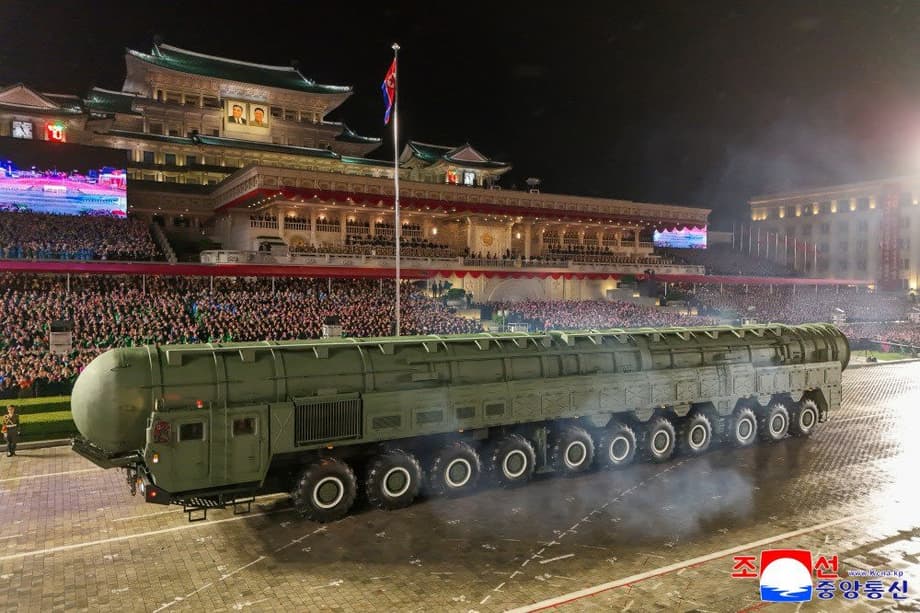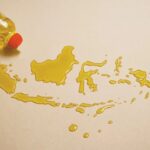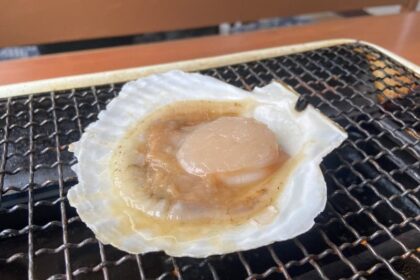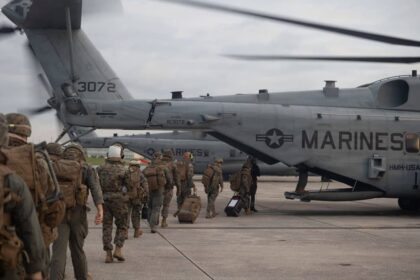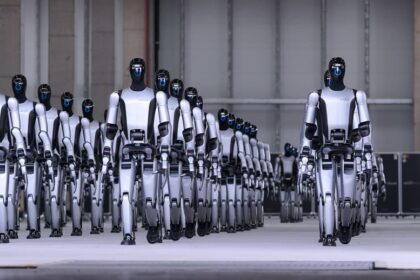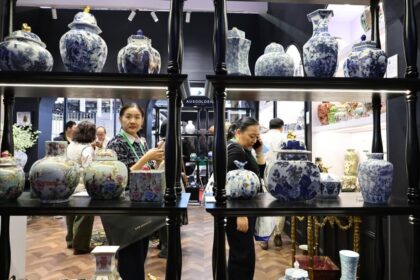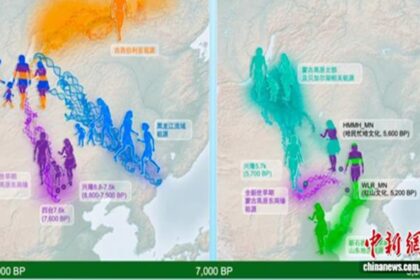A showcase of new missiles and deeper ties with China and Russia
North Korea marked the 80th anniversary of the Workers Party of Korea with a late night military parade in Pyongyang that combined hardware, pageantry, and politics. The event highlighted two systems that state media cast as central to the country’s strategic posture, a new short range hypersonic glide weapon known as Hwasong-11Ma and a new intercontinental ballistic missile, the Hwasong-20. The display was calibrated for multiple audiences. It signaled domestic strength and technological progress, warned regional adversaries of advancing capabilities, and underscored closer alignment with Beijing and Moscow through the appearance of Chinese Premier Li Qiang and Dmitry Medvedev, deputy chairman of Russia’s Security Council, on the reviewing stand alongside leader Kim Jong Un.
The missiles were rolled through Kim Il Sung Square under bright lights before large crowds, part of a tradition in which Pyongyang uses parades to reveal new systems or upgraded variants. The Hwasong-11Ma drew attention for its maneuverable glide body and solid fueled booster, attributes that shorten launch preparation and complicate interception. The Hwasong-20, presented as the country’s most powerful nuclear delivery system, appeared on an 11 axle transporter and in a sealed launch canister, signaling a shift toward solid fuel ICBMs that are easier to move and conceal. The parade arrived after Kim’s recent trip to Beijing and a period of stepped up public messaging about weapons advances, a sign that Pyongyang wants both recognition of its deterrent and greater bargaining power as it navigates growing pressure from the United States, South Korea, and Japan.
What North Korea rolled out
The lineup presented a broad mix of strategic and conventional systems. Long range missiles dominated the finale, but the ground forces also showed new armor and rocket artillery, while air and maritime strike assets were represented by cruise missiles and loitering munitions. The curated array suggested a plan to saturate defenses with diverse salvos, from low altitude cruise missiles and drones to high speed ballistic and glide vehicles.
Hwasong-11Ma hypersonic glide vehicle
The Hwasong-11Ma is a short range ballistic missile fitted with a boost glide vehicle. After a brief rocket powered climb, the glide body detaches and flies unpowered at very high speed on a flattened, maneuvering path. That profile makes its flight less predictable than a traditional arc, compresses detection and tracking timelines, and can stress missile defenses designed around fixed trajectories. North Korean tests of hypersonic glide vehicles date back to at least September 2021, and in January 2024 the country reported using a solid fueled booster for a hypersonic trial. Solid propellants permit faster firing from mobile launchers, reduce conspicuous fueling activity, and improve survivability in a crisis.
Analysts have long noted similarities between North Korea’s short range systems and Russia’s Iskander family, including the KN-23. The glide body seen on the Hwasong-11Ma has a broad, flat planform intended to generate lift at hypersonic speeds above Mach 5, allowing energy to be traded for range and maneuver. North Korean media also cited work on a new high thrust rocket motor for this class of weapon earlier this year, suggesting continued upgrades to boost performance and payload options. Some experts view Russia’s wartime use of the air launched Iskander variant, the Kinzhal, as an operational case study, although there is debate over how effective Kinzhal has been in Ukraine. Even with mixed battlefield results, a maneuvering hypersonic profile complicates defensive planning around the Korean Peninsula.
Hwasong-20 intercontinental ballistic missile
The Hwasong-20 made its first public appearance in the parade. State media has described it as a solid fueled ICBM built with carbon fiber composite materials and powered by a motor reportedly producing 1,971 kilonewtons of thrust. Officials in Pyongyang have said that the engine underwent multiple ground static fires, with nine tests cited, and that the same propulsion package is intended to support the Hwasong-19, another long range system. The missile rode atop a large 11 axle mobile launcher and appeared to be contained in a canister, which is consistent with a cold launch approach common to solid fueled road mobile missiles.
No flight test of the Hwasong-20 has been announced, and parade canisters can conceal the exact configuration or even whether a missile is inside. Even so, the design hints at North Korea’s desired end state. Analysts see a blunt nosed payload section that could be configured for multiple independently targetable reentry vehicles, commonly known as MIRVs. If Pyongyang eventually masters that technology, it could place several warheads on a single booster and assign each to a different aimpoint, complicating interception by limited homeland defenses and challenging regional defense architectures. There are still open questions about guidance accuracy and heat shield performance at intercontinental velocity, issues that normally require full range trials to verify. The Hwasong-20 nevertheless signals that North Korea wants a faster firing, more survivable ICBM road fleet.
Other systems on the move
Beyond the headline missiles, the parade spotlighted a mix of tactical and conventional assets. North Korea showed upgraded Cheonma-20 main battle tanks and a 155 millimeter self propelled howitzer that appear aimed at narrowing gaps with South Korean K2 tanks and K9 howitzers. A new 22 tube wheeled multiple rocket launcher drew comparisons with South Korea’s Chunmoo system and the US made Himars. The air and maritime strike portfolio included Hwasal series long range cruise missiles that Pyongyang has previously claimed could threaten US assets in Guam and carrier groups in regional waters. Short range ballistic systems like the KN-24 and the very large caliber KN-25 featured as well.
One notable debut was a loitering munition that resembles Israel’s Harop, carried on a six cell mobile launcher. That system fits with Kim’s directive from 2024 to expand unmanned aerial systems. The mix of drones, rockets, ballistic missiles, and cruise missiles suggests doctrine that favors simultaneous launches from multiple domains to overwhelm radar coverage and interceptor stocks. Parade coverage also noted units from the Strategic Force Service and Special Operations formations, which are central to nuclear and conventional strike missions.
How hypersonic glide vehicles challenge defenses
Hypersonic glide vehicles begin life like ballistic missiles. A rocket boosts the payload to speed and altitude, then the glide body separates and skips or slides along thinner layers of the atmosphere. Instead of following a predictable arc, the vehicle can adjust its heading and altitude while sustaining very high speed. That behavior frustrates algorithms that predict an interception point and shrinks the window for engagement. Systems such as Patriot and Aegis are optimized for ballistic or aerodynamic targets with more stable paths. A glide body that dips lower than a classic ballistic trajectory may hide under some radar horizons and then pop up on sensors much later in flight.
North Korea’s approach pairs this glide technology with short range boosters similar to the KN-23 family. The result is a fast, maneuvering threat sized for striking air bases, command nodes, and missile defenses in South Korea and parts of Japan. While hit to kill interceptors and advanced radar networks can adapt, they face the tactical problem of uncertain aimpoints, compressed timelines, and the need to conserve interceptors against salvos. Russia’s experience with Kinzhal in Ukraine is frequently cited in this debate. Ukrainian and allied officials have claimed multiple Kinzhal interceptions, while Moscow has touted successful strikes. Even amid those competing claims, military planners treat maneuvering hypersonic threats as higher risk targets that require more shooters, better cueing, and closer integration of sensors.
Is the Hwasong-20 ready for fielding
The Hwasong-20’s parade debut aligns with a clear trajectory in North Korean missile development. Solid fuel ICBMs reduce launch timelines, avoid conspicuous liquid fueling operations, and are easier to deploy on road mobile launchers. The canister presentation and the cited use of carbon fiber composites are consistent with modern designs that seek lower structural mass and higher motor performance. State media has described the Hwasong-20 as the country’s most powerful nuclear strategic weapon system. If paired with a post boost vehicle and a bus that can release multiple reentry bodies, an operational Hwasong-20 could carry several warheads or a mix of warheads and penetration aids.
Concrete proof will require flight tests that demonstrate ignition from the canister, stage separation, guidance performance, and reentry survivability at intercontinental speed. Technical details from the parade drew attention from defense watchers. Some observers noted that the transporter erector launcher displayed lacked the familiar dual stabilizing jacks seen on earlier heavy TELs, a possible sign of weight distribution changes or that the launcher is still evolving. In South Korea, lawmakers and former officers speculated publicly about the TEL’s support layout, underscoring how carefully both sides scrutinize these set pieces for clues.
Before the parade, outside experts pointed to the likelihood that Pyongyang would validate the system in the near term. Ankit Panda, a senior fellow at the Carnegie Endowment for International Peace, assessed the direction of travel for North Korea’s long range program and the intended effect on US defenses.
“The Hwasong-20 represents the apotheosis of North Korea’s ambitions for long range nuclear delivery capabilities, and the system is expected to be tested before the end of the year.”
North Korean state media reinforced that narrative with elevated language about the new missile’s role in the country’s deterrent.
“[Hwasong-20 is] the country’s strongest nuclear strategic weapon system,” the Korean Central News Agency said.
A parade steeped in diplomacy
The presence of China’s Li Qiang, Russia’s Dmitry Medvedev, and Vietnam’s party chief To Lam offered an overt political message. It cast North Korea as a committed partner in a growing alignment of socialist and non Western states and delivered a public show of support for Kim at a time of sharper confrontation with Washington, Seoul, and Tokyo. The optics followed Kim’s recent visit to Beijing, where North Korea underscored its ties with China, and came amid expanding practical cooperation with Russia.
North Korean personnel who had served in Russia appeared in parade units carrying both nations’ flags, a rare public nod to a sensitive role. Kim referenced those deployments in prepared remarks. He praised the heroism of troops performing missions beyond North Korea’s borders and urged the armed forces to grow stronger. In a line directed at domestic and foreign audiences alike, he framed the army’s mission as eliminating threats to the state.
“The army should continue to grow into an invincible entity that destroys all threats,” Kim said.
Russian dignitaries reciprocated the message. After meeting Kim in Pyongyang, Medvedev hailed the contribution of North Koreans who fought for Russia in Ukraine and described shared goals for deeper cooperation.
“The sacrifice of North Korean soldiers fighting for Russia is proof of trust between our two countries,” Medvedev said, adding that Moscow seeks broader exchanges with Pyongyang.
Officials in the United States, South Korea, and Japan have accused North Korea of supplying artillery, rockets, and ballistic missiles to Russia for use in Ukraine, a charge that would violate United Nations sanctions. Pyongyang and Moscow have highlighted their right to mutual defense ties but have not published full details of the transfers. The parade setting, with soldiers from the Russia front in attendance and visible warmth between North Korean and Russian leaders, indicated that both sides see political advantage in advertising the partnership.
What it means for defenses in the region and beyond
North Korea’s hypersonic short range systems are designed to challenge South Korea’s layered air and missile defense, which includes Patriot, Aegis destroyers, and the THAAD battery deployed south of Seoul. Maneuvering glide vehicles strain the algorithms and timelines that those systems depend on, encouraging defenders to spread sensors more widely, hold more ready interceptors, and coordinate faster across services. Low flying cruise missiles such as the Hwasal series add a different challenge, slipping under radar coverage and demanding persistent airborne or forward radar pickets.
For the United States, the prospect of a solid fueled ICBM with multiple warheads threatens to saturate the small fleet of Ground based Midcourse Defense interceptors that protect the homeland. Even if North Korea remains years away from a fully validated MIRV system, the intent to move in that direction is a warning signal for Washington. A single missile carrying multiple aimpoints or advanced decoys would force US war planners to assign more interceptors per incoming object and could reduce confidence in stopping a small salvo. Japan faces similar dilemmas at sea, where Aegis ships must weigh the number of available Standard Missile interceptors against the size and timing of a potential mixed attack.
How much of this is real
Parades are theater and policy at once. North Korea has a history of rolling canistered missiles across the square before a flight ready version exists. Even after a design is mature on paper, the leap from ground testing to reliable fielded system takes time. Motors must demonstrate stable burn, stages must separate cleanly, guidance packages must survive violent vibrations, and heat shields must carry a payload through reentry. MIRVs, if pursued, multiply those challenges by requiring a post boost vehicle that can orient and release multiple bodies precisely while under stress. Nothing shown on Friday proves that those milestones are complete.
There is still value in attending to the details. The shift to solid fuel across short, medium, and long range systems is real and accelerates firing sequences. The steady appearance of drones, cruise missiles, and large bore rocket artillery points to a doctrine that favors saturation and redundancy. The continued presence of Chinese and Russian delegations at headline events, combined with public praise for North Koreans who served in Russia, signals a political environment that encourages North Korea to keep testing and fielding. Even without a full flight test of Hwasong-20, the direction is clear. Pyongyang is building more mobile, survivable, and diverse means of delivering nuclear and conventional strikes, and it is comfortable showing them off.
Key Points
- North Korea’s parade marked the 80th anniversary of the Workers Party of Korea and featured the debut of the Hwasong-11Ma hypersonic weapon and Hwasong-20 ICBM.
- The Hwasong-11Ma uses a boost glide vehicle and a solid fueled booster to fly at hypersonic speed on an unpredictable path.
- The Hwasong-20 is a solid fueled, canistered ICBM that state media calls the most powerful nuclear strategic weapon system, though no flight test has been announced.
- Analysts think the Hwasong-20 could eventually carry multiple independently targetable reentry vehicles, but guidance and reentry capability remain unproven.
- Foreign guests included China’s premier, Russia’s Dmitry Medvedev, and Vietnam’s party chief, underscoring deepening ties.
- North Korean troops who served in Russia joined the parade, and Kim praised overseas missions while urging the army to become an invincible entity.
- The parade also displayed upgraded Cheonma-20 tanks, a new 22 tube rocket launcher, Hwasal cruise missiles, KN-24 and KN-25 systems, and a loitering munition launcher.
- Hypersonic glide vehicles and potential MIRVs challenge US and allied missile defenses by compressing timelines and saturating interceptors.
- North Korea’s move toward solid fuel across its missile forces shortens launch preparation and makes mobile systems harder to detect and target.


